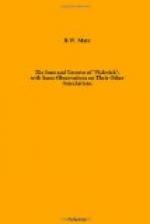[illustration: The “Black Boy,” Chelmsford. From an old engraving]
Before Mr. Pickwick carried out his determination to pursue Jingle, he had occasion to visit the “Magpie and Stump,” “situated in a court, happy in the double advantage of being in the vicinity of Clare Market and closely approximating to the back of New Inn.” This was the favoured tavern, sacred to the evening orgies of Mr. Lowten and his companions, and by ordinary people would be designated a public-house. The object of Mr. Pickwick’s visit was to discover Mr. Lowten, and on enquiry, found him presiding over a sing-song and actually engaged in obliging with a comic song at the moment. After a brief interview with that worthy, Mr. Pickwick was prevailed upon to join the festive party.
[illustration: The “George the Fourth,” Clare Market. Drawn by C. G. Harper]
There were, at the time, two taverns, either of which might have stood as the original for the “Magpie and Stump”; the “Old Black Jack” and the “George the Fourth,” both in Portsmouth Street, and both were demolished in 1896. Which was the one Dickens had in mind it is difficult to say. His description of its appearance runs as follows: “In the lower windows, which were decorated with curtains of a saffron hue, dangled two or three printed cards, bearing reference to Devonshire cyder and Dantzic spruce, while a large blackboard, announcing in white letters to an enlightened public that there were 500,000 barrels of double stout in the cellars of the establishment, left the mind in a state of not unpleasing doubt and uncertainty, as to the precise direction in the bowels of the earth in which this mighty cavern might be supposed to extend. When we add that the weather-beaten signboard bore the half-obliterated semblance of a magpie intently eyeing a crooked streak of brown paint, which the neighbours had been taught from infancy to consider as the ‘stump,’ we have said all that need be said of the exterior of the edifice.”
The “Old Black Jack” has been identified as the original of the “Magpie and Stump” by some topographers, whilst Robert Allbut in his Rambles in Dickens-land favoured the “Old George the Fourth,” adding that Dickens and Thackeray were well-remembered visitors there.
The Bull Inn, Whitechapel, the starting-place of Tony Weller’s coach which was to take Mr. Pickwick to Ipswich, was actually at No. 25 Aldgate, and was perhaps the most famous of the group of inns of the neighbourhood whence many of the Essex, Suffolk and Norfolk coaches set out on their journeys. At the time of which we write it was owned by Mrs. Ann Nelson, whose antecedents had been born and bred in the business, while she herself had interests in more than one city hostelry, as well as owned coaches.




